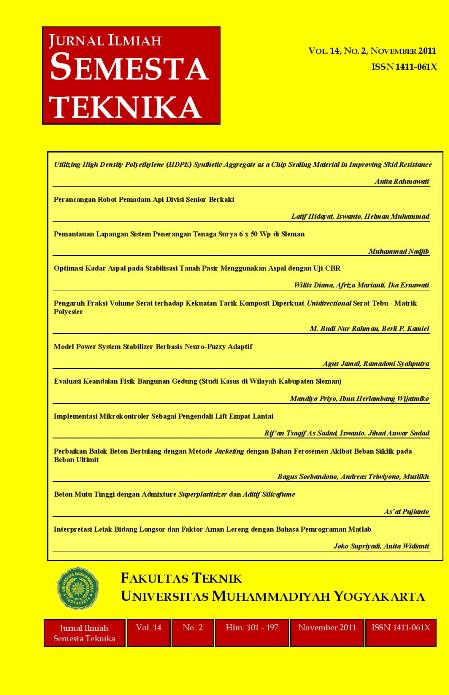Utilizing High Density Polyethylene (HDPE) Synthetic Aggregate as a Chip Sealing Material in Improving Skid Resistance
DOI:
https://doi.org/10.18196/st.v14i2.538Abstract
There are four main factors causing traffic accident : human factor, vehicle factor, road factor and environment factor. Accident data from Poltabes Yogyakarata in 2007 showed that road factor causes accident is 2.45%. In effort to achieve traffic safety, the infrastructure must be considered in the first list. This research is dealing with “Utilizing High Density Polyethylene (HDPE) Synthetic Aggregate as a Chip Sealing Material in Improving Skid Resistance”. The purpose of this research is to understand the effect of chip sealing using HDPE synthetic aggregate on the skid resistance, so that the surface pavement can provide good service for traffic and road users and the quantity of accident can be reduced. In this research the skid resistance was measured using British Pendulum Tester such that the its skid resistance is also called British Pendulum Number (BPN). BPN is a measured based on 3 variations of aggregate weight being spreaded, that are 240 grams, 271 grams and 304 grams. The result of BPN will be correlated with the wet accident ratio, friction coefficient and stopping distance. The BPN values being obtained are 55.96, 55.6 and 53.4, respectively. The BPN was found to increase with the increase of aggregate weight in chip seal mixture. It was revealed that BPN with chip sealing using HDPE could be increased by approximately 10 % in comparison with that without chip sealing. In addition, chip sealing using HDPE can reduce the accident ratio by 47.32 %, improve the traffic safety by 47.32 %, and shorten the stopping distance. The greater friction coefficient the lower stopping distance, and the lower stopping distance the better traffic safety.
Downloads
Published
How to Cite
Issue
Section
License
Semesta Teknika is licensed under a Creative Commons Attribution 4.0 International License.
Authors who publish with this journal agree to the following terms:
- Authors retain copyright and grant the journal right of first publication with the work simultaneously licensed under a Creative Commons Attribution License that allows others to share the work with an acknowledgement of the work's authorship and initial publication in this journal.
- Authors are able to enter into separate, additional contractual arrangements for the non-exclusive distribution of the journal's published version of the work (e.g., post it to an institutional repository or publish it in a book), with an acknowledgement of its initial publication in this journal.
- Authors are permitted and encouraged to post their work online (e.g., in institutional repositories or on their website) prior to and during the submission process, as it can lead to productive exchanges, as well as earlier and greater citation of published work (See The Effect of Open Access).









